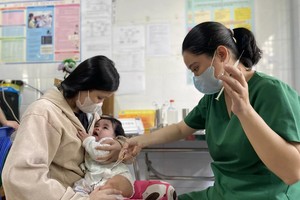At a press conference in Hanoi on May 14, health officials announced that since last April the bizarre skin disease that has been plaguing the central province of Quang Ngai is still a mystery, as no such disease has ever been recorded in any medical document.
The conference in Hanoi was meant to highlight the dangers of the disease and the unknown causes, one being suspected to be high toxic substances in malnutritioned patients.

Nguyen Thanh Long, Deputy Minister of Health, said that medical experts found no signs of contagious infection, which meant that the condition is not caused by a virus or bacteria. This was revealed after the ministry completed a fact-finding mission in Ba To District in Quang Ngai Province.
The ministry also dismissed the idea that a transmissible disease was responsible for the 21 deaths and over 205 cases from April 19, 2011 to May 13, 2012.
There was no evidence of a virus or bacteria in the tested water, air, soil or food samples. There is no proof that the disease is transmitted through air, water or between humans, Long said.
Noticeably, the deputy minister said experts found mouldy fungus and Aflatoxin in rice samples which were nearly five times higher than in other areas. Aflatoxin, a toxic fungus, is recorded in medical documents in the world for causing chronic and acute liver damage. Kenya and India have experienced epidemics caused by the toxic with high fatality rates of over 26 per cent.
In healthcare journals, people suffer from dermatitis but no liver damage and vice versa; consequently, the health sector will focus on the relation between skin dermatitis and liver damage.
The ministry has still not identified the cause of the disease, called inflammatory palhoplantar hyperkeratosis syndrome, which is characterised by thickened skin over the palms and soles. A majority of the patients also develop liver problems.
The deputy minister said that more than 1,900 diseased samples had been collected for testing in laboratories nationwide with the support of international experts from the World Health Organisation, the US Centre for Disease Control and Prevention (CDC) and Japan.
The ministry also confirmed that they would collaborate closely with WHO, CDC and other international organisations to find the cause of the disease.
Long affirmed that the ministry is targeting to reduce the affliction in people; subsequently, it ordered medical experts and medics from central hospitals to provide training to local healthcare workers.
Moreover, disinfectants have been sprayed and the government has distributed new mattresses, blankets and mosquito nets to residents in Ba Dien Commune as well as medicines to local residents.
























